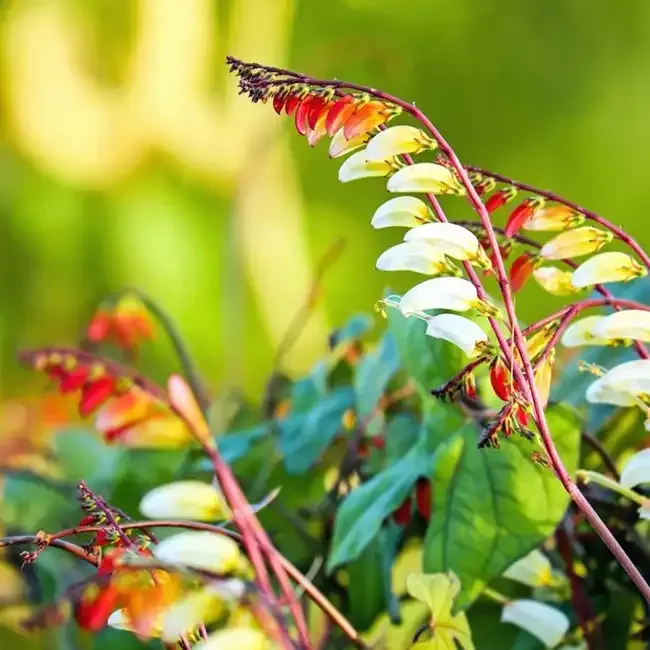
This is one of my favorite vining flowers. It is also a top ten for hummingbirds. In fact in my garden this is tied with cardinal flower as the most visited flowers by hummingbirds. If you are looking for a plant that attracts hummingbirds this is the one to get. In my area (zone 7a) is is a tender annual so I need to replant every year, but it is worth it.
Fortunately, ipomoea lobata is fast-growing. It has a unique color gradient of blooms, ranging from fiery red to soft yellow, resembling the colors of the Spanish flag, which gives it its common name. Besides its aesthetic appeal, it is also known for attracting pollinators, particularly hummingbirds, making it a popular choice for pollinator gardens.
A Top Hummingbird Attractor
One of the most remarkable features of Ipomoea lobata is its ability to attract hummingbirds. The tubular shape of the flowers, combined with their bright, warm colors, makes them irresistible to these small, nectar-feeding birds. Gardeners looking to create a hummingbird-friendly environment often include the Spanish flag in their plant selection, as it provides an abundant nectar source during its blooming period, which typically lasts from mid-summer to early fall.
Native Region
Ipomoea lobata is native to Central and South America, particularly found in regions of Mexico and Brazil. In its natural habitat, it thrives in tropical and subtropical climates, climbing up trees and other structures. This plant’s adaptability to various environments has led to its cultivation in gardens worldwide, where it adds a touch of tropical vibrancy to temperate zones.
Soil and Moisture Requirements
Ipomoea lobata is a relatively low-maintenance plant, provided its basic needs are met:
- Soil: The Spanish flag prefers well-draining soil that is rich in organic matter. While it can tolerate a range of soil types, including sandy or loamy soils, it thrives best in fertile ground that retains some moisture without becoming waterlogged. Slightly acidic to neutral soil pH levels (6.0-7.5) are ideal.
- Moisture: Regular watering is essential, especially during the growing season. The soil should be kept consistently moist but not soggy. Overwatering or poorly drained soil can lead to root rot, a common issue for many vining plants. Mulching around the base of the plant can help retain moisture and keep the roots cool during hot weather.
Tips for Caring for Ipomoea lobata
To ensure your Ipomoea lobata thrives and remains a focal point in your garden, follow these care tips:
- Planting Location: Choose a sunny location for planting, as Ipomoea lobata requires at least six hours of direct sunlight each day to produce abundant blooms. In hotter climates, some afternoon shade can help protect the plant from excessive heat.
- Support Structures: Since Ipomoea lobata is a climbing vine, providing support is crucial. Trellises, arbors, or fences work well, allowing the plant to grow vertically and display its cascading flowers to their full effect.
- Feeding: Fertilize the plant with a balanced, water-soluble fertilizer every 4-6 weeks during the growing season. This helps promote healthy growth and flowering. Avoid excessive nitrogen, which can lead to lush foliage but fewer flowers.
- Pruning: Regular pruning helps manage the plant's growth and encourages bushier, more floriferous development. Deadheading spent blooms can also extend the flowering period.
- Overwintering: In colder climates, Ipomoea lobata is grown as an annual, as it cannot tolerate frost. To enjoy it year after year, you can collect seeds from mature pods at the end of the season or grow the plant in containers that can be brought indoors during the winter months.
Ipomoea lobata, with its striking appearance and pollinator-friendly attributes, is a wonderful addition to any garden. Whether you're looking to attract hummingbirds or simply want to enjoy the vibrant colors of the Spanish flag, this easy-to-grow vine offers a unique blend of beauty and ecological value. By providing the right conditions and care, you can ensure that your Ipomoea lobata becomes a stunning centerpiece in your garden year after year.
